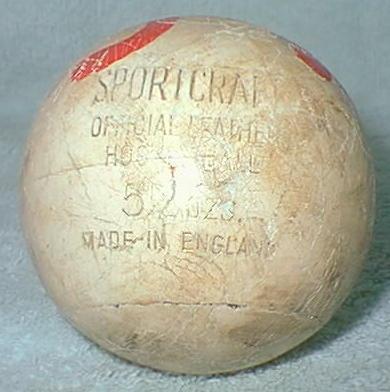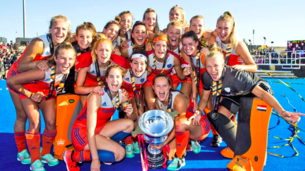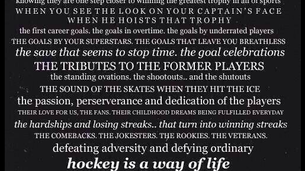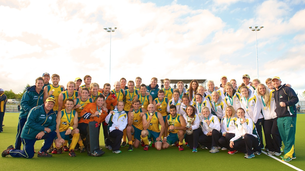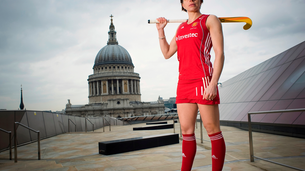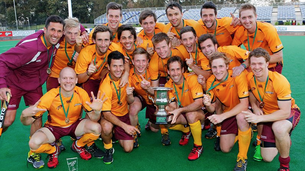FIELD HOCKEY
Field Hockey - or just Hockey, as it's known in most countries around the world, and is played by all age groups, both female and male. Most players are amatuer, with some professional players and leagues in Australia, Europe, England, India, Malaysia and Spain.
The biggest two field Hockey tournaments are the Olympic Games tournament, and the Hockey World Cup, which is also held every 4 years. Apart from this, there is the Champions Trophy held each year for the six top-ranked teams. Field Hockey has also been played at the Commonwealth Games since 1998. The Sultan Azlan Shah Hockey Tournament and Sultan Ibrahim Ismail Hockey Tournament is for the junior team but both tournaments are held annually in Malaysia, and becoming a prominent field Hockey tournaments where teams from around the world participate to win the cup.
Field Hockey is a game of possession, elimination, tackling and scoring.
- - Be able to maintain possession of the ball, both individually, pairs and team play
- - Eliminate opponents chances one-on-one and by defensive positioning
- - Tackles are made by placing the stick head or shaft into the path or directly at the ball
- - Penalty corners & strokes lead to goals, but individual scoring skill by attackers is best
At the highest level, field Hockey is a fast-moving, highly skilled sport, with players using fast moves with the stick, quick accurate passing, and hard hits, in attempts to keep possession and move the ball towards the goal. Tackling with physical contact and otherwise physically obstructing players is not permitted, Some of the tactics used resemble soccer, but with greater ball speed.
The game is played on a rectangular field, which measures 91.4m x 55m. There is a goal at each end, which is a square box measuring 2.14m high and 3.66m wide. A semi-circle is drawn on the ground 16 metres in front of this goal, which is referred to as the shooting circle. There is a further semi-circle of dotted lines 5 metres from the shooting circle, as well as lines drawn across the field 22.9m from each end line in the centre of the field. These lines mark the third end of the pitch. The penalty spot (or the strobe mark) is placed 6.4m from the centre of each goal on this line.

Each player carries a field Hockey stick that normally measures between 80–95 cm (31–38") long; shorter or longer sticks are available. Sticks were traditionally made of wood, but are now often made also with fibreglass, kevlar and/or carbon fibre composites. Metal is forbidden from use in field hockey sticks, due to the risk of injury from sharp edges if the stick were to break. The stick has a rounded handle, has a J-shaped hook at the bottom, and is flattened on the left side (when looking down the handle with the hook facing upwards). A stick that is designed to be used left-handed is not permissible in play.

There was traditionally a slight curve (called the bow, or rake) from the top to bottom of the face side of the stick and another on the 'heel' edge to the top of the handle (usually made according to the angle at which the handle part was inserted into the splice of the head part of the stick), which assisted in the positioning of the stick head in relation to the ball and made striking the ball easier and more accurate.
The hook at the bottom of the stick was only recently the tight curve (Indian style) that we have nowadays. The older 'English' sticks had a longer bend, making it very hard to use the stick on the reverse. For this reason players now use the tight curved sticks.
Field Hockey balls are hard spherical balls, made of plastic (sometimes over a cork core), and are usually white, although they can be any colour as long as they contrast with the playing surface.
The balls have a circumference of 224–235 mm (8.8–9.3 in) and weigh 156–163 g (5.5–5.7 oz). The ball is often covered with indentations to reduce aquaplaning that can cause an inconsistent ball speed on wet surfaces.
Simplified Rules of Field Hockey
The ball can only be hit on the flat side of the stick. There are no left-handed sticks. The left hand should always be above the right hand when dribbling, shooting or passing. Do not hold the stick cross-handed.
The ball cannot be played with either the feet or the hand.
There is no body checking in field Hockey. Sticks cannot be used to hit other players.
There is no off-side rule.
A player cannot obstruct if he is stationary, no matter which way he is facing: he must move into a position to obstruct and the obstructing player must be actively trying to play the ball. A player can turn away from a tackler so long as the ball is held in front, and the player moves away from the tackler.
Ball offback line: last touched by attacker, 16 yard hit to defender; last touched by defender, corner to attackers. Ball hit off back line intentionally by defender or goal keeper - penalty corner.
Accidental infraction by defender in circle or intentional infraction inside 25 yard line - penalty corner.
All free hits within 5 yards of circle - everyone must be 5 yards away.
Penalty corner: five defenders behind goal line: ball pushed out by attacker from point 10 yards from post, defenders can run out after ball: ball must move outside the circle and then go back inside before a shot taken. If a shot is 'hit' it must be higher then the backboard - 18", if flicked it can be higher.
Intentional infraction in circle or unintentional infraction preventing a sure goal - penalty stroke
Penalty stroke: time out, all players behind 25 yard line except goalkeeper and hitter. Goalkeeper stationary with heels on line. When umpire sees both goalkeeper and hitter are ready - blows whistle. Hitter must start behind ball and must then push or drag flick ball - not hit. Goalkeeper saves or ball misses net - 16 yard hit.
Goalkeepers have the most protective equipment of all field Hockey players. Face masks for defensive players can be worn for short and/or penalty corners.
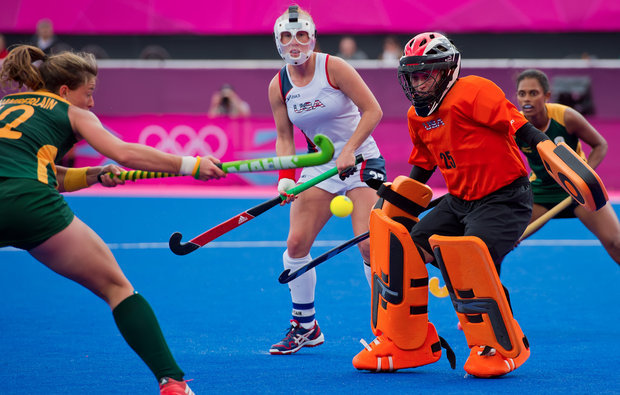
A fully equipped goalkeeper must wear a helmet, leg guards and kickers. Usually the field Hockey goalkeepers must wear extensive additional protective equipment including chest guards, padded shorts, heavily padded hand protectors, groin protectors, neck guards, arm guards, and like all players, they must carry a stick. However, such a player may not cross the 23 m line, the sole exception to this being if the goalkeeper is to take a penalty stroke at the other end of the field, when the clock is stopped. The goalkeeper can also remove their helmet for this action. However, if the goalkeeper elects to wear only a helmet (and a different colored shirt), they may cross the 23 m line if they have removed their helmet (and placed it safely off the field of play). If play returns to the circle without them having opportunity to replace the helmet, this player still has "goalkeeping privileges", that is, they are not limited to using their stick to play the ball whilst it is in the circle, and the helmet must be worn whilst defending penalty corners and penalty strokes but the best thing to do would be to wear it at all times. It is now also even possible for teams to have a full eleven outfield players and no goalkeeper at all. No player may wear a helmet or other goalkeeping equipment, neither will any player be able to play the ball with any other part of the body than with their stick. This may be used to offer a tactical advantage, or to allow for play to commence if no goalkeeper or kit is available.
Prior to the start of the game, a coin is tossed and the winning captain can choose a starting end or start with the ball. The game time is divided into two equal halves of 35 minutes each, with 5–10 minutes for half-time, although at local and regional level, games may be reduced to 25- to 30-minute halves to ease turf availability constraints. At the start of each half, as well as after goals are scored, play is started with a pass from the centre of the field. All players must start in their defensive half (apart from the player making the pass), but the ball may be played in any direction along the playing surface. Each team starts with the ball in one half, and the team that conceded the goal has possession for the restart.
The teams' object is to play the ball into their attacking circle and, from there, hit, push or flick the ball into the goal, scoring a goal. The team with more goals after two 35-minute halves wins the game.
HISTORY
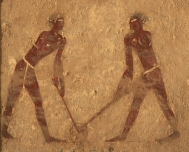
Wall painting from Tomb of Kheti in Beni Hasan, Egypt. 12th Dynasty. Circa 1960 BC
A ancient bully off with two figures with Hockey sticks and a ball.
Here is a depiction of a Hockey-like game between circa 510 and 500 BC in Ancient Greece when the game may have been called "Κερητίζειν" ("kerētízein") because it was played with a horn ("κέρας" in Greek) and a ball-like object.
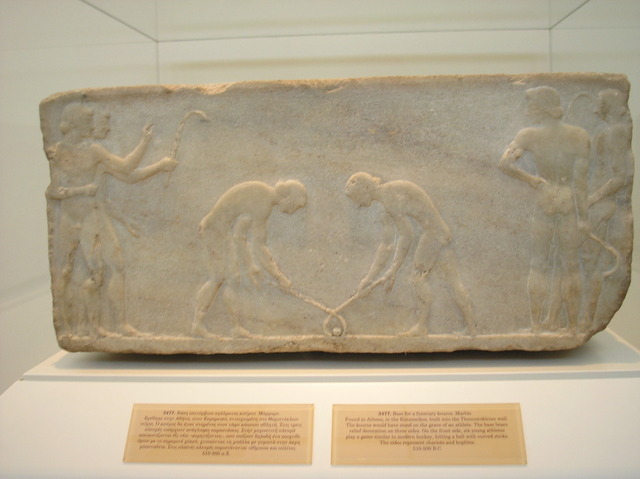
Part of a base for funerary kouros. Marble. Found in Athens, in the Kerameikos, built into the Themistokleian wall. The kouros would have stood on the grave of a athlete. The base bears relief decoration on three sides. On the front side, six young athletes play a game similar to modern field Hockey.

The Daur people of Inner Mongolia, China, have been playing Beikou a game with some similarities to field hockey for about 1,000 years. The Daurs are one of the smallest of China’s 56 ethnic minorities, with a population of 100,000. They are descended from the Khitan, a nomadic people who founded the Liao dynasty in the 10th century, and although the children are taught Mandarin in school, they continue to speak their own unwritten language. And they are fiercely proud of their heritage, a cornerstone of which is field hockey
Decretals of Gregory IX circa 1300 to 1340 (Smithfield Decretals) show a ancient bully off with two figures with Hockey sticks and a ball.
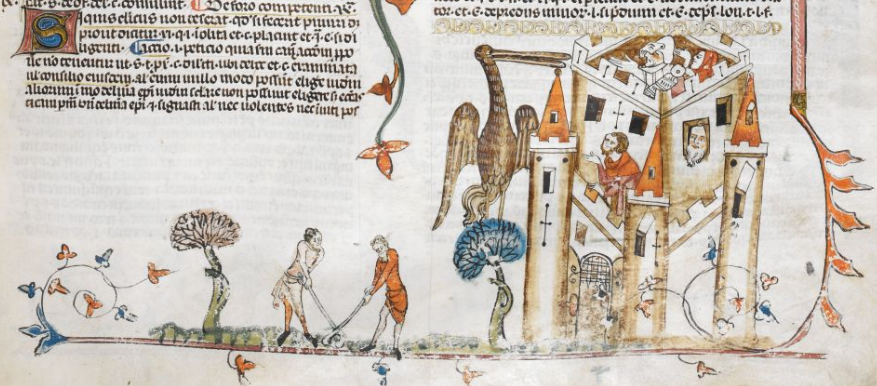
Narrative scenes in colours added in London, England probably on the request of John Batayle, a canon of St Bartholomew's at Smithfield. The script is Gothic, and the language is Latin.
There is a small stained glass figure of a Hockey player in The Great East Window, in the east wing of the Gloucester Cathedral, England - circa 1340
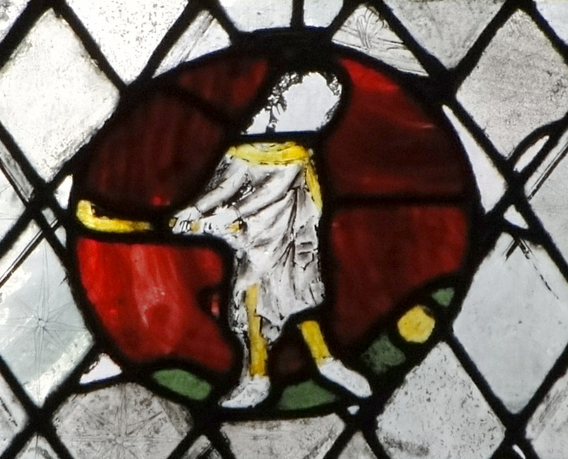
Hockey was illegal in England from 1363 to being repealed in 1784, for under a statute of Edward III all sports were banned because they interfered with archery.. Below is the extract from the prolaclamation issued by the King to the Lord Lieutenant of Kent under :
"Games supplant Archery AD. 1363"

The King to the Lord Lieutenant of Kent, greeting :
Whereas the people of our realm, rich and poor alike, were accustomed formerly in their games to practice archery - whence by Gods help, it is known that high honour and profit come to our realm, and no small advantage to ourselves in our warlike enterprises - and that now skill with the bow having fallen almost wholly into disrepute, our subjects give themselves up to the throwing of stones and of wood and of iron; and some to handball and football and hockey, and others to coursing and cock-fights, and even to other unseemly sports less useful and manly, whereby our realm which God forbid, will soon it would appear, be void of archers.
WE, wishing that a fitting remedy be found in this matter, do hereby ordain that, in all places in your country, liberties or no liberties, whatsoever you shall deem fit, a proclamation be made to this effect ; that every man in the same country, if he be able-bodied, shall upon holidays, make use in his games, of bows and arrows ... and so learn and practice archery. Moreover we ordain that you prohibit under penalty of imprisonment all and sundry from such stone, wood and iron throwing ; handball, football, or hockey ; coursing and cock-fighting ; or other such idle games.
This prolaclamation was the 1st recorded use of the word Hockey
In the book Juvenile Sports and Pastimes by Richard Johnson, published in London, England, Second Edition 1776, there is a chapter titled 'New Improvments on the Game of Hockey' and states: This sport can be purfued no where with pleasure, but in a wide spacious field , where the Hockey may have its full scope. This game may be played by any even number of boys, divided into two parties. Each party must fix their goal at the greatest distance from one another the field will admit of, leaving however about ten feet space between each goal and the extromity of the field. The goals need consist only of a very long piece of brier, each end being struck in the ground, and thereby forming a kind of erect arch. The goal at the upper end of the field is called the upper goal, and the other the lower : the parties who play are likewise distinguished in the same manner.

Everyone who plays must be provided with a Hockey stick. This is a matter of no small consequence, as I have known a boy give another almost any thing for one which has pleased his fancy ; and I myself have parted with a minced pie upon the same occasion. I will now give you the description of a good Hockey - flick. It is no matter what wood it is, so that it is tough, not liable to break, and has the desired form. It must be about a yard long, or rather in proportion to the size of the sportsman. The top of it, I mean that part of it which you hold in your hand, may be as thick as a common walking-stick ; but the thicker it is at the bottom the better. The bottom, however, must not be strait, but crooked, and that in the form of a shepherd's crook is valuable beyond everything. The use of the crook part is to disengage the Hockey from your antagonists, when it is so surrounded by them that you cannot get at it to give it a full stroke toward their goal.
The kockey must be made of the largest cork-bung you can get. Cut the edges round, and then it is prepared for use.
The goals being fixed, the Hockey prepared, and the parties agreed on, you then proceed to your sport in the following manner. Both parties meet as nearly as possible, in the middle between the two goals, when the Hockey is tossed up, and everyone tries his best to beat the Hockey through the the goal of his antagonist ; which being once accomplished, the game is over. I have known a game last for two or three hours, though followed up with the greatest ardour and alacrity, such have been the excellant sportsman who composed the two parties.
There is a wide difference in merely playing this game, and playing it genteely. Some boys are of such an eager, warm disposition, that they care not whom they hurt, or whose skin they break, so that thet get at the kockey ; but this is the mark of a bad player. A right sportsman is always cool, and ready to take any advantage that offers, without having recourse to unfair proceedings. When he sees the kockey is so surrounded by both parties, that he cannot get a fair stroke at it, he makes one among them with his crook, and endeavours to get between, so that, by a sudden jerk, he may disengage it from him ; while others, who are as good players as himself on the other side, will endeavour to prevent it, by beating their Hockey sticks against his, and at the same time aiming to give it such strokes as may force it their away. All this may be done without giving or recieving the least cause for complaint.
According to the rules of this game, you are never to touch the kockey with your hands, from the time it is tossed up till it is got through one of the goals ; and, tho' you are allowed to push either of your antagonists aside, yet it is confidered not only as foul play, but as very ungenteel also, to strive either to throw another down, or trip up his heels. Such proceedings always produce ill-will, quarrelling, and somtimes fighting : but every young gentleman will wish to make his companion as happy as himself, since sport in the world will be rendered dull, insipid, and disgustful.
William Pierre Le Cocq stated, in a December 17, 1799 letter written in a boarding school in the Vicarage at Chesham, England to his parents , “I must now describe to you the game of Hockey; we have each a stick turning up at the end. We get a bung. There are two sides one of them knocks one way and the other side the other way. If any one of the sides makes the bung reach that end of the churchyard it is victorious.
The 1st club was founded in London, England by the Blackheath Hockey and Football Club in 1861. On October 1,1864 during the AGM, it was carried unanimously that 'The Club shall be called The Blackheath Hockey Club.
The 1st Club President was Colonel Hillyard.
According to the book “Hockey” published in 1899 by Philip A. Robson and J. Nicholson Smith:- “This club was formed not later than the year 1840. Members are still living who were playing at that date”
The Blackheath Hockey Club originally played with a 7oz solid rubber cube as a ball, along with catching, marking and scrimmaging based on rugby football

Blackheath Hockey Club 1894
The Teddington Cricket Club experimented with the game of field Hockey between 1871 and 1874, and then began to formulate rules for the game of field Hockey.
MORE FIELD HOCKEY HISTORY TO BE ADDED :-)
The Stick has come in many shapes and curves of the crook / head throughout history. Starting in 1860, the stick became flat on the playing side - the left position where the toe of the crook / head of the stick is facing away from the player.
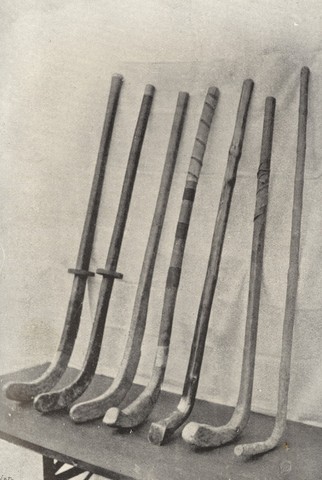
The Leicestershire & Rutland Hockey Associations of England offer a history of the game revealing that early sticks were made from bamboo. British Hockey players eventually switched to available local woods, such as willow.
In the 1850s & 1860s the stick used was generally of Maple, the crook / head being bent by steam.
The 1870s sticks were made from Oak, as it was generally stronger, heavier and gave a better grip.
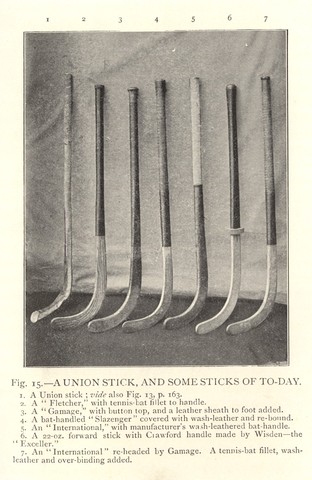
In 1970, composite materials were permitted in the manufacturer of field Hockey sticks.
In 1980, the design of the stick was changed to a much smaller head for better stick handling and control.
The Ball has given origin to many popular pastimes, and were usually practised in the fields and other open places. The most ancient amusement of this kind, is distinguished with us by the name of hand-ball, and is, if Homer may be accredited, coeval at least with the destruction of Troy. Herodotus attributes the invention of the ball to the Lydians; succeeding writers have affirmed, that a female of distinction named Anagalla, a native of Corcyra, was the first who made a ball for the purpose of pastime, which she presented to Nausica, the daughter of Alcinous, king of Phœacia, and at the same time taught her how to use it; this piece of history is partly derived from Homer, who introduces the princess of Corcyra with her maidens, amusing themselves at hand-ball:
Their shining veils unbound, along the skies,
Tost and retost, the ball incessant flies.
Homer has restricted this pastime to the young maidens of Corcyra, at least he has not mentioned its being practised by the men; in times posterior to the poet, the game of hand-ball was indiscriminately played by both sexes.
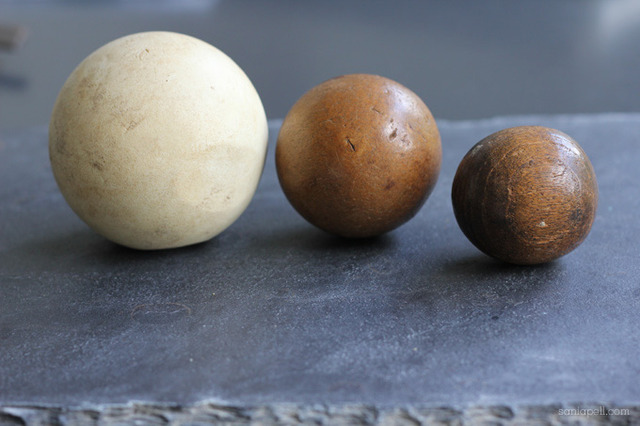
Field Hockey balls have been made from knots of wood, string covered wood balls, bungs - made from cork, solid cubes of pure black indian rubber and cricket balls.
